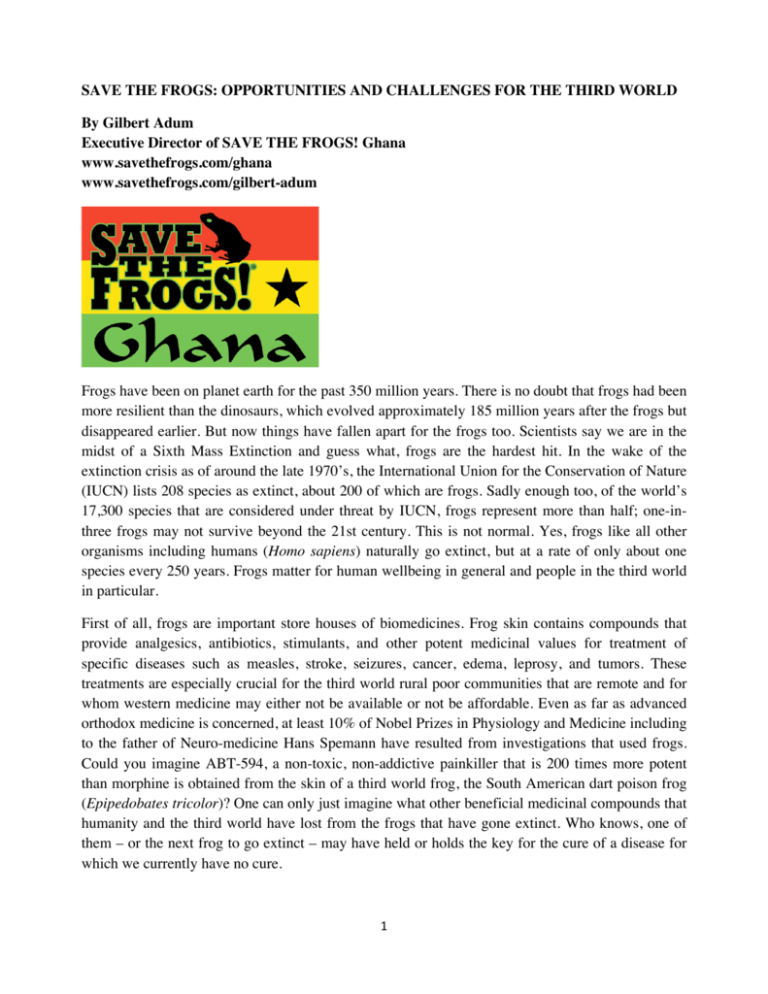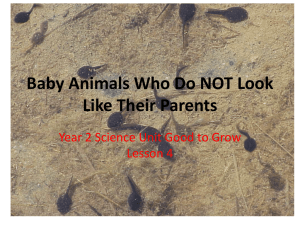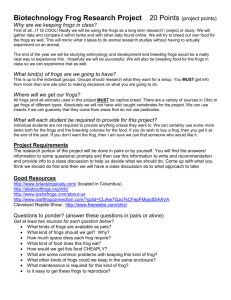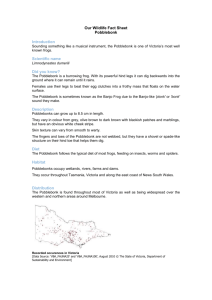Opportunities and challenges for the third world
advertisement

SAVE THE FROGS: OPPORTUNITIES AND CHALLENGES FOR THE THIRD WORLD By Gilbert Adum Executive Director of SAVE THE FROGS! Ghana www.savethefrogs.com/ghana www.savethefrogs.com/gilbert-adum Frogs have been on planet earth for the past 350 million years. There is no doubt that frogs had been more resilient than the dinosaurs, which evolved approximately 185 million years after the frogs but disappeared earlier. But now things have fallen apart for the frogs too. Scientists say we are in the midst of a Sixth Mass Extinction and guess what, frogs are the hardest hit. In the wake of the extinction crisis as of around the late 1970’s, the International Union for the Conservation of Nature (IUCN) lists 208 species as extinct, about 200 of which are frogs. Sadly enough too, of the world’s 17,300 species that are considered under threat by IUCN, frogs represent more than half; one-inthree frogs may not survive beyond the 21st century. This is not normal. Yes, frogs like all other organisms including humans (Homo sapiens) naturally go extinct, but at a rate of only about one species every 250 years. Frogs matter for human wellbeing in general and people in the third world in particular. First of all, frogs are important store houses of biomedicines. Frog skin contains compounds that provide analgesics, antibiotics, stimulants, and other potent medicinal values for treatment of specific diseases such as measles, stroke, seizures, cancer, edema, leprosy, and tumors. These treatments are especially crucial for the third world rural poor communities that are remote and for whom western medicine may either not be available or not be affordable. Even as far as advanced orthodox medicine is concerned, at least 10% of Nobel Prizes in Physiology and Medicine including to the father of Neuro-medicine Hans Spemann have resulted from investigations that used frogs. Could you imagine ABT-594, a non-toxic, non-addictive painkiller that is 200 times more potent than morphine is obtained from the skin of a third world frog, the South American dart poison frog (Epipedobates tricolor)? One can only just imagine what other beneficial medicinal compounds that humanity and the third world have lost from the frogs that have gone extinct. Who knows, one of them – or the next frog to go extinct – may have held or holds the key for the cure of a disease for which we currently have no cure. 1 Frogs are also integral part of the food web. Chief Seattle, the 19th century native American certainly made this point worth considering, “humankind has not woven the web of life. We are but one thread within it. Whatever we do to the web, we do to ourselves. All things are bound together. All things connect." What more, frogs are predators and prey at the same time and thus serve as an important link between different food web levels. They often occur in very high densities in many ecosystems, being thus highly relevant elements of their habitats and summing up to a huge proportion of the local biomass. As predators, they feed on a variety of organisms such as agricultural pests and mosquitoes, ensuring in the reduction of the amount of agrochemicals usage, and the spread of mosquito-related diseases such as malaria. The filter feeding larvae – tadpoles – are furthermore important in keeping waterways clean by feeding on algae. As prey, frogs serve as an important food source to diverse groups of predators including fish, birds, mammals and reptiles. Thus, the well-being and food security of people in the third world in particular are highly dependent on the persistence of frogs. Again, in the words of Chief Seattle, “whatever we do to the web” - causing frogs to disappear – is not without dire consequences for our ecosystems. Moreover, frogs are “living like a canary in a coal mine” as they are playing the same role like a canary in early coal mine, whose death sounded a warning that poisonous or explosive gases have reached a dangerous level. Frogs may be victims of their own success. Because of their permeable skins they can easily absorb toxic chemicals, making them susceptible to pollution and other environmental disturbances. However, for that fact they are considered excellent indicators of environmental health. In addition, as frogs live at the interface between terrestrial and aquatic ecosystems their health could be indicative of the health of the entire biosphere. Given that third world countries are economically poor and have limited wide-ranging taxonomic experts, this intrinsic trait of frogs can be realized more fully as a cost-effective means for Biodiversity Rapid Assessment Programs. But the disappearances of the frogs as they ushered in the Sixth Mass Extinction and remain the most affected to date is also a clear warning there is something terribly wrong with our environment and we must fix it. Frogs, so to speak may not be “charismatic” like elephants, tigers and lions but they are unique and appealing in many respects. If for anything frogs are cool. Frogs have varying colours that they need for the sake of camouflage and as a warning of toxicity. Accidentally these colours are just beautiful and radiant. Photographs and drawings of the frogs as used in many advertisements, books, and video games are some of the suggestive testimonies. “I always thought that frogs were cool, no matter what anyone said. It now turns out, they're useful too, but most of them are dead” (frog poetry by Emily Mann). Well, we know what the causes of the frogs’ die-offs are. Most of the causes in the third world stem from the insatiable quest for such countries to develop to be at par with the so-called developed world. Habitat destruction is the most common and greatest threat to the survival of frogs. Frogs are habitat specific and more so are dependent upon the quality of their habitats, not size per se. The loss of their habitats to developmental projects, farming et cetera has often, therefore, meant automatic irreversibility of frogs’ ability to survive. Many frog species have been endangered as a result and 2 for locally endemic frogs – and (of which many frogs are) – they have gone extinct. Take the case of the extinction of the Tanzanian Kihansi Spray Toad (Nectophrynoides asperginis) for instance. This unusual frog occupied the smallest natural distribution known for any vertebrate species, living in about 20,000 m2 (220,000 sq ft). It went extinct in the wild because the Tanzanian government through a loan from the World Bank constructed a hydro-electric dam on its one and only habitat range on earth. Afterward, regrettably the two perpetrating parties spent more money and time than otherwise for the frog’s captive breeding and re-introduction. Such gratuitous gargantuan waste of capital could have been avoided if the responsible agencies cared a little about this frog and the environment. Still in Africa, and worst of all the so-called Sub-Saharan Africa’s model country Ghana, the extinction of the Critically Endangered Togo Slippery Frog (Conraua derooi) is imminent. In its bid to industrialize and to draw more value from its natural resources, the Ghanaian government intends to develop its struggling bauxite industry. But the aggressive pursuit of intensive mining is putting great pressure on the Atewa Range Forest Reserve, which is the only home of this frog. It will be environmentally destructive if such regulatory permission is granted for the clearing of this forest, considering its high ecological and social value. Atewa is not only the final destination of the Critically Endangered Togo Slippery Frog but as well harbours one of the healthiest and most important ecosystems in Western Africa region. It is the crown jewel of Ghana’s biodiversity, and thus must be protected from mining interests. - Phrynobatrachus latifrons from Ankasa National Park, Ghana Farming is another prime culprit. Within the last century, due to exponential population growth in all third world countries, the conversion of natural habitats into agricultural habitats became apparently a necessary evil for securing food for local populations. Well understood. But unfortunately, virgin forest lands especially in biodiversity hotspots including those areas that support many threatened and endemic frogs have been preferred. In the Upper Guinean Rainforest of West Africa, farming has led to the clearing of over 50% of the region’s forest, endangering at least 32% of the frogs. In Asian hotspots (especially Southeast Asia), amidst the discoveries of new frogs, the region has the world’s worst rates of deforestation through largely oil palm plantation. The new frogs would better be undiscovered than being described as extinct at discovery! Also in 3 developing South America and the Amazon, the world’s largest powerhouse of biodiversity, rapid destruction of the forest to pave way for especially soy is the primary cause for which the region also has the highest endangered number of frogs. Such news of destroying natural vegetation for farming in the name of feeding the third world goes on and on. Let’s also consider the secondary effects of farming on frogs. Novel research has revealed that many of the agrochemicals used in the name of agricultural intensification in the third world are not friendly at all to frogs. Atrazine for example is a number one killer to frogs. Outrageously, this chemical turns female frogs into males, disrupting indefinitely their ability to reproduce. Frogs that may be “lucky” not to have the Atrazine changing their sexes will get mutilated by it anyhow and will suffer missing limbs or deformed parts and end up dying. Kudos to SAVE THE FROGS!, a US-based amphibian nonprofit organisation, for leading in the worldwide actions that would ban the production and use of Atrazine. More importantly, it is necessary for third world countries to embrace and practise Green Agriculture whereby lands put under agriculture are managed sustainably – organic farming if possible – for frog conservation. Logging is another major threat to the survival of frogs. Logging remains the most significant threat to forests in the third world and contributes substantially to their continued degradation. It is estimated that of the remaining 9 million km2 of primary forest worldwide, between 50,000–70,000 km2 are logged annually. About three-quarters of the forests made available for logging are in the third world. At these ongoing rates of logging including the pervasive illegal logging activities by local people, indications are that by the year 2050 only about 10% of extant primary forests may remain. But already, long-term studies in third world regions such as West Africa have led to the claims that logging caused the disappearance or even local extinction of some endangered and endemic frogs (Hyperolius bobiriensis, H. torrentis Arthroleptis brevipes, Conraua derooi and Werneria africana). Other studies in Guyana and Ivory Coast have also revealed that recovery of frogs following even selective-logging is not possible within 30 years. For the third world, logging is lucrative; frogs also matter. Do we ecologise economics or economise ecology? There can only be one way forward; striking a proper balance between ecology and economics. It would be best for frogs’ critical habitats such as those for critically endangered species that are yet to experience logging to remain and be protected as unlogged. Alternatively, going by outstanding research findings by leading conservation scientists notably myself (Adum), Lindenmayer and Putz and their co-workers respectively, at worst when logging can not be avoided then the retention approach should be favoured. Unlogged patches such as designated as Important Frog Areas need to be created and retained within logged areas to serve as sinks to offset species loss. In addition, already logged places that are of equal critical specialty for endangered frog species’ needs could also be designated as such and thenceforth be protected permanently from future logging activities. 4 - Night Spirit Frog (Leptopelis spiritusnoctis) from Ankasa National Park, Ghana A fungal pathogen known as Batrachochytrium dendrobatidis (Bd) is also responsible for many of the especially recent frogs’ die-offs. In fact, it is becoming more of a threat than habitat loss. Bd is water-borne, and this puts frogs in an inescapable fix. It is agreed by the IUCN and endorsed by the World Health Organisation (WHO) that the disease caused by Bd, known as chytridiomycosis, is “the worst infectious disease ever recorded among vertebrates in terms of the number of species impacted, and its propensity to drive them to extinction.” It has and is decimating frogs around the world especially in places such as Australia, New Zealand, Central America, North America and Europe. It does occur also in some parts of Africa and Asia, and for that matter it is found on all the continents of the world. At least half of the 200 frog species that have gone extinct have been attributable to it. In the New World frog genus (Atelopus) alone, chytridiomycosis has been responsible for the extinction of at least 71 frogs. For now like its cousin HIV/AIDS, there is yet no known cure for this deadly disease. However, thankfully, like HIV/AIDS both its infection and spread is preventable. And prevention is better than cure! The global frog trade, which has the third world as its cradle birthed the disease and if there should be any success in curbing it, the trade has to be disallowed. Under special circumstances (e.g. transporting frogs for the purposes of laboratory investigations), as made mandatory by the World Organisation for Animal Health, it needs to be enforced that such frogs get quarantined for the disease. Secondly and more importantly, the third world lags far behind in terms of educating its populace about the disease. So far in most regions, I can say that for West Africa, the knowledge of the disease is restricted among handful local frog experts and not to even general wildlife practitioners. The UN through WHO and IUCN needs to treat the disease seriously by for instance mandating third world party countries to create public awareness like the cases of pandemics or epidemics such as HIV/AIDS, swine flu and, ebola. Humans are also “Eating Frogs to Extinction.” In their paper of the quoted title, Warkentin and coworkers estimated that worldwide, between 100 million and a billion frogs are taken from the wild for food each year. A report by the UN on the trade indicates that France and the US are the largest 5 importers, importing about 80 million of frog meat yearly for the past 20 years. It is none but third world countries notably Indonesia, China, Taiwan and Vietnam that export to these countries. Indonesia alone exports approximately about 80 million of frog legs, and those sold on the domestic market are twice as much. Another study revealed that in West Africa thirty-two frog meat traders handled approximately 2.7 million frogs per year, and there could be as many as 100s of traders involved in the trade. Although it has been difficult to monitor the harvest and trade impacts on individual species, there are compelling evidences in all these affected areas that the frog populations are decreasing. It is on record that when the Indian bullfrog (Hoplobatrachus tigerinus) and the green pond frog (Euphlyctis hexadactylus) became the two most sought after species in India and Bangladesh for the frog meat trade their respective populations collapsed by the late 1980’s. Many people have suggested third world countries should practice frog farming to feed their own appetites and also export while securing wild frog populations. Such a thing never worked in the US when farmers tried raising American Bullfrogs. Lessons learnt are that farmed frogs usually escape into the wild becoming invasive, eating up native frogs. Worst of all, the farmed frogs are also often carriers of diseases including the deadly chytridiomycosis, with which they infect wild frog populations. The best possible option and wisest thing for third world frog eaters and traders to do is to say no to frog meat and seek alternative sources of protein. With an educated public that appreciates nature and wildlife, there is still time to SAVE THE FROGS! But we must act quickly. Written in 2012 by: Gilbert Adum Executive Director & Co-Founder SAVE THE FROGS! Ghana Box KS 15924, Adum-Kumasi, Ghana E-mail: gilbert@savethefrogs.com Website: www.savethefrogs.com/ghana Phone: +233-(0)263182586 6







